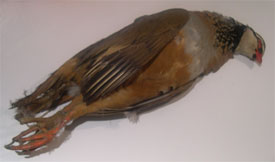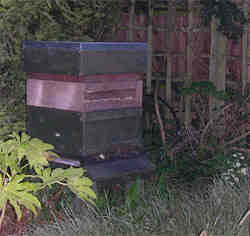How to pluck and draw game: a partridge or pheasant.
Posted by Fiona Nevile in Basics, Pheasant and Game | 80 comments Game is a treat. We don’t shoot and I don’t know many people who do. Hero of the kitchen garden, John Coe, is a beater during the winter months and sometimes brings us a brace of pheasant. His presents are always hung and dressed, ready for the pot.
Game is a treat. We don’t shoot and I don’t know many people who do. Hero of the kitchen garden, John Coe, is a beater during the winter months and sometimes brings us a brace of pheasant. His presents are always hung and dressed, ready for the pot.
Occasionally we’re given a brace of pheasant or partridge, complete with feathers Until today, I have hung, skinned and drawn them, and then cooked them slowly, enclosed in a casserole. Now I know how to pluck a bird. By keeping the skin our repertoire of recipes has increased tenfold. The skin contains fat and makes for a more succulent bird. Roasting is now a possible option.
I’m working at a lovely house in Upend at the moment. Yesterday Carol and Patrick gave me a brace of partridge. I was delighted and spent a happy split second planning how to cook them. As I skin my game the Romanian way, there is only one recipe that really suits game prepared in this way. It’s mouth watering and will appear on this blog after Christmas. Update: 27 January 2007, we have now developed two more exellent recipes for skinned game. Check out the recipes section of the blog.
I was always a bit envious of people who could pluck game, imagining it to be a complex and fiddly procedure. Today I discovered that it’s not. When Patrick found out that I didn’t know how to pluck a bird he immediately volunteered to give me a lesson. He rustled up a carrier bag; I grabbed the birds they had given me. Patrick demonstrated and within minutes I was plucking my first bird. The plucking is straightforward. Dealing with fluttering feathers is not. Hence the carrier bag.
How to hang, pluck and draw a partridge or pheasant
- Hang the bird for a couple of days (by the neck) in a cool place such as a garage or cold larder.
- Cut off the head at the base of the neck with a decent pair of scissors. (Once you have got rid of this the whole procedure seems less ghoulish).
- snap the lower legs at the joints and pull out the tendons. This takes some strength.
- Cut off the wings at the joint. (you will find this in the fold between the wing and the body.)
Plucking the feathers:
It is easier to pluck a bird when it is warm. Let a bird reach room temperature before plucking, it makes an enormous difference
- Find a carrier bag (any supermarket one will do)
- Stand your carrier bag on a table, workbench, or in the sink (I use the sink) the bird will be plucked into this. Pull up the sides of the carrier bag so that you have an enclosed area in which to contain the plucked feathers.
- Put a few sheets of newspaper around your working area to catch any stray feathers.
- Hold the bird by the legs and brush the feathers on the breast and back (against the grain, so to speak) so they sit up a little. With small neat movements pluck the feathers away and down from the bird, ideally straight into the carrier bag.
If skin comes away on the base of the feathers you are being too rough or trying to remove too many feathers at once. Experiment a little with this. You will soon get the feel of the most efficient plucking movement. I place my fingers on the skin around the plucking area.this stops the skin being plucked from the carcass along with the tips of the feathers. - Spread the tail feathers into a fan shape and pluck these following the line of the feather.
- To remove the leg feathers, hold the body and brush the feathers smooth (with the grain) and pluck them sharply down in that direction.
Another friend sits down to pluck a bird, with a dustbin liner between her knees. The feathers are plucked with a short downwards movement, straight into the bag. It’s worth experimenting with different plucking methods to find one that suits you best. I find that some feathers are more easily removed ‘against the grain’ and some ‘with the grain’. The secret is in the short precise plucking movement. If you can get into a relaxed rythm it’s easy.
Drawing the bird
- Remove the crop (from the head end) by gently putting a finger into the neck opening, rotating gently and pulling the crop out. If you are curious, you can open this to see what the last meal was. Remove the gullet and windpipe.
- Now stick your forefinger up the birds bum. Rotate it gently and draw out the liver and guts. We freeze the livers to use in an excellent terrine.
- Wash the bird (inside and out) and refrigerate for a couple of days before use.
If your bird smalls bad chuck it away, contained in a couple of tightly sealed carrier bags. Sometimes gun dogs will pick up a lost bird from a day or so before. This is rare but it has happened to us.
Skinning a bird:
Follow the steps for ‘How to hang, pluck and draw a partridge or pheasant’ then put your finger under the skin around the neck and loosen the skin. Hold the skin firmly and pull gently down towards the tail. The skin and feathers should come off in one piece. Once skinned, don’t forget to draw the bird (see above). Roasting is really out if you have skinned your bird but any casserole or recipe that encloses the bird will probably be sucessful. See our pheasant recipes, these were all cooked with skinned game and are excellent.
Leave a reply






Quick question.
The dogs have finally caught a pheasant that has been wandering around for a few days. But I didn’t get a chance to bleed it as I had no knife on me when they caught it. Think it died of a broken neck or just plain shock. I have it hanging now. Will it still be alright to eat un-bled? Or will it affect the flavour of the meat?
Hi Clare
You don’t have to bleed te pheasant so it should be fine! As the weather is warm don’t hang it too long though! 2 days at most.
Absolutely superb information , i was given a brace of partridges and hadn’t a clue how to prepare them .The information on your website made it very straightforward , although at first i thought i was going to see “ralph” i continued and suddenly it all came together and looked just like they had been bought from the local butcher,thankyou.
hi how long can i keep a goose before i have to pluck it
Hi Ann
I would say two or three days max – somewhere cold like a garage. Bring it up to room temperature before plucking.
Hi can you tell me how long I can keep a goose before I pluck it & freeze it
Regards
Ann
Hi I’ve just come home to find three ducks hanging on my door and a bottle of wine….from my neighbour. I don’t have a clue where to start. I found your website and it’s really helpful. However, there’s no mention of bleeding the duck. These have been shot, so what do I do about the blood?
Hi Susan
The blood will take care of itself. Just haang the ducks (by the necks) for a couple of days or so – a cold garage is ideal. Bring them up to room temperature before plucking. There’s a wonderful recipe for teal in red wine on the site – which works well with wild duck and is superb with pheasant too
https://www.cottagesmallholder.com/dukes-teal-au-vin-or-tippled-teal-in-cider-recipe-contributed-by-duncan-lang-6522
I found a dead duck in a pond. Do you think it’s worth plucking and eating it?
No way!
Hello Fn, I’ve been quite busy lately working on my latest,– Easy Pluck C/P (Chicken/Pheasant)a plucker powered with your drill motor, to keep the price down, I will ship a donated one to Nicaragua possibly tomorrow and I would be happy to donate one to The Cottage smallholder for you to auction of, (Proceeds to a charity or the running of your forums) Product giveaway, just for signing in or however you want to do this,shoot me an email at rod AT pluckwitheasypluck.com Thanks, ROD
Hi Rod
Thank you so much for this generous offer. I will email you today!
Hi Richard
Great that yoiu found these instructions useful. We haven’t been given any game to date this season – sonorous sob. We have loads of easy pheasant recipes on the blog if you are lucky enough to get one.
Thanks for this! I have just used your advice to pluck and draw a small pheasant hen that our friends’ dog caught and killed. Just hope we don’t ruin it now in the cooking!
Fn, You are very welcome …Lead a quiet life and let your actions speak, help where you can!!!
Thank You, ROD